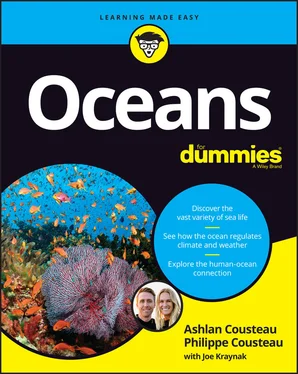1 ...6 7 8 10 11 12 ...23 Reduce pollution: Pollution in the air, water, and even on land ends up in the ocean. Sources of pollution include plastics (which never really biodegrade), sewage, industrial chemicals, agricultural fertilizers and pesticides, land runoff (especially from streets and parking lots), oil spills, ocean mining, littering, and the use of certain sunscreens.
Fish sustainably: Overfishing combined with destructive fishing methods are devastating marine wildlife populations risk. International legislation and enforcement are crucial for ensuring a sufficient supply of seafood for ourselves as well as marine ecosystems.
Create marine protected areas (MPAs): MPAs are areas where certain consumptive or destructive activities are prohibited for the purpose of protecting ecosystems, sustaining fisheries production, or preserving cultural resources.
Engage youth: The best way to make lasting change is from the ground up. It starts by educating the youth. They’re best equipped to change their own behaviors and influence the minds, hearts, and actions of parents, teachers, government representatives, community members, and business leaders.
For more about threats to the ocean and what we can do to preserve it for future generations, see Chapter 21.
Pretty cool, huh? The ocean is an amazing place, and we hope that reading this book makes you fall in love with the ocean for the first time … or all over again; that you learn, laugh, maybe even shed a tear; and, most importantly, that you’re inspired, knowing YOU have the power to help our mighty ocean.
Chapter 2
Appreciating the Ocean’s Many Gifts
IN THIS CHAPTER
 Breathing easy with a healthy ocean
Breathing easy with a healthy ocean
 Getting to know the world’s largest weather machine
Getting to know the world’s largest weather machine
 Discovering where billions of people get a good chunk of their protein
Discovering where billions of people get a good chunk of their protein
 Gauging the impact of the ocean on the global economy
Gauging the impact of the ocean on the global economy
 Dipping into the ocean for inspiration and innovation
Dipping into the ocean for inspiration and innovation
The ocean covers 71 percent of the planet, contains 97 percent of the planet’s water, is home to 50 to 80 percent of all life on Earth (94 percent of life on Earth is aquatic), and supplies at least 50 percent of the world’s oxygen, (scientists estimate it’s anywhere from 50 to 80 percent, according to NOAA). It serves up about 200 billion pounds of seafood each year and supplies an important source of protein for billions of people around the world. It plays a big role in transportation, both travel and shipping, and a huge role in regulating climate and weather and making Earth habitable. It is drilled for crude oil, mined for minerals, tapped for development of new medications, and desalinated to provide drinking water. It is home to some of the most beautiful and amazing creatures on the planet and is an unfathomable source of wonder. We literally can’t live without it.
The ocean is truly a gift that keeps on giving. Every planet wants one, other planets and moons across the universe probably have them, but Earth is the only planet we know of that has such a healthy, vibrant ocean teeming with life.
In this chapter, we look at the many ways the ocean makes Earth habitable and such a wonderful place to live, not to mention all the valuable resources it provides to us. Think of this chapter as a celebration of Ocean Appreciation Day.
 Actually, there is no Ocean Appreciation Day, but there is a World Oceans Day, when people around the world celebrate the ocean, commit to restoring and protecting it, and join in a number of conservation activities and events around the world. We encourage you to celebrate this day annually on June 8. (Visit
Actually, there is no Ocean Appreciation Day, but there is a World Oceans Day, when people around the world celebrate the ocean, commit to restoring and protecting it, and join in a number of conservation activities and events around the world. We encourage you to celebrate this day annually on June 8. (Visit worldoceansday.org for details.)
Supplying Over Half of the World’s Oxygen
You’ve probably heard the Amazon described as “the lungs of our planet.” However, while this incredible ecosystem is very important, rainforests supply only about 28 percent of the oxygen on our planet. That’s nothing to sneeze at, unless, of course, you’re allergic to rainforests. So where does the other roughly 70 percent come from? Well, over half of all oxygen produced on Earth comes from the sea (by some estimates it is as high as 80 percent!). While most of it is consumed by marine organisms, a small fraction of it escapes and over geologic time has given rise to an atmosphere that is about 20 percent oxygen, which has made life as we know it possible. Thank you, ocean. And this is mostly thanks to microscopic plantlike organisms floating in the sea, the tiny but mighty phytoplankton. (See Chapters 7and 8for more about phytoplankton and other ocean plants.)
Powered by the sun, these microscopic wonders turn carbon dioxide and water into sugar and oxygen through the process of photosynthesis, as do plants that grow on land (and in your flower pots), but it performs this magic on a much larger scale. According to some estimates, phytoplankton account for only one percent of all the biomass on our planet. Now, that may be a tiny slice of the pie, but they are able to conduct nearly as much photosynthesis as all the land plants that account for a much larger fraction of that pie. Without phytoplankton creating oxygen in the ocean, life on Earth, in its current form, could not exist.
Playing a Key Role in Regulating Climate and Weather
The ocean is like a massive version of the heating, ventilation, and air-conditioning (HVAC) units used to heat and cool most homes, but instead of circulating hot and cold air, it captures heat from the sun and distributes it through the circulation of water. Imagine Earth’s frozen poles as air conditioners, the equator as its heater, and the ocean as the blower and ductwork, distributing the heat and cold all around the world.
Ocean currents transport warm water from the equator to the poles and cold water from the poles to the tropics. These currents act like a gigantic conveyor belt, moving warm and cool water to areas of contrasting temperature, thereby keeping the entire planet at a fairly comfortable 58.3 degrees Fahrenheit (on average). Sure, that’s sweater weather for people and might make a polar bear break out in a sweat, but as an average temperature it’s perfect.
Without ocean currents, regional temperatures would be more extreme — super hot at the equator and far more frigid than it already is at the poles — and much less of Earth’s land would be habitable. See Chapter 16for more about how the ocean circulates water and Chapter 17for how it influences climate and weather.
DIFFERENTIATING CLIMATE FROM WEATHER
Nobody has trouble with the concept of weather because it impacts us every day. We check weather forecasts daily to plan our outdoor activities, to find out how to dress ourselves and our kids, to decide whether or not to carry an umbrella, and more. On the other hand, many people struggle with the concept of climate. For example, some people wonder how climate change (or global warming, as it is sometimes called) can be real when they experience a rogue snowstorm in the spring.
Читать дальше

 Breathing easy with a healthy ocean
Breathing easy with a healthy ocean Actually, there is no Ocean Appreciation Day, but there is a World Oceans Day, when people around the world celebrate the ocean, commit to restoring and protecting it, and join in a number of conservation activities and events around the world. We encourage you to celebrate this day annually on June 8. (Visit
Actually, there is no Ocean Appreciation Day, but there is a World Oceans Day, when people around the world celebrate the ocean, commit to restoring and protecting it, and join in a number of conservation activities and events around the world. We encourage you to celebrate this day annually on June 8. (Visit 










